Feeding the birds that visit your home is one of the most rewarding ways to attract and observe wild birds. Starting a feeding hobby will take a little time, an investment in a feeder or two, and food to go in them. The trick to feeding is choosing the right combination of foods and feeders to attract the birds you want to see.
In Maryland, the most productive time to hang up bird feeders is November through April when natural foods aren’t as readily available. During breeding season, over 90% of our songbirds feed their young insects. So, while feeders may still be used by adults, birds really need insects which can be attracted by planting native species.
For a printout of commonly observed feeder birds in Maryland,
 please check out our PDF here.
please check out our PDF here.
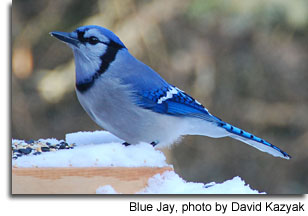
What and How to Feed Wild Birds
Bird species have certain tastes when it comes to the food they eat and how it is presented to them. By tailoring the foods you offer to your favorite birds, you increase your chances of attracting them. Seeds for birds are readily available to wild bird lovers. The best seeds to buy are those that most birds eat. Choices of seed for birds fall into seven main categories:
Black Oil Sunflower
Black oil sunflower seed is rich in fats and proteins needed by a variety of birds. Chickadees, doves, finches, goldfinches, grosbeaks, Northern Cardinals, nuthatches, Pine Siskins, titmice and woodpeckers all enjoy black oil sunflower seed.
Common Seed Mixes
These mixes attract a variety of non-native birds including European Starlings, House Sparrows and pigeons. Many of these mixes also contain a substantial amount of red milo which only a few species of bird in the southwest eat.
Hulled Sunflower
Also known as sunflower hearts, hulled sunflower is chopped up pieces of sunflower seeds without the coats. Chickadees, Common Redpolls, Dark-eyed Juncos, doves, finches, goldfinches, grosbeaks, nuthatches, Pine Siskins, titmice and woodpeckers all like hulled sunflower seed.
Nyjer (formerly known as thistle)
Nyjer is an imported seed that comes from African daisies, not thistles. It is a favorite of Common Redpolls, Dark-eyed Juncos, doves, finches, goldfinches, Indigo Buntings and Pine Siskins.
Safflower
Safflower is generally found in higher end bird seed mixes. Northern Cardinals, Doves, Purple Finches and titmice all forage on safflower while “feeder hogs” like grackles and starlings tend to avoid it.
Striped Sunflower
Striped sunflower seeds are a favorite of many birds and people. Chickadees, doves, grosbeaks, Northern Cardinals, nuthatches, titmice and woodpeckers all eat striped sunflower seed.
White Proso Millet
Both sunflower and millet can be found in mixes or can be fed separately. Most sparrows prefer millet and are not particular about where they eat. Dark-eyed Juncos, doves, Indigo Buntings and towhees also enjoy white millet.
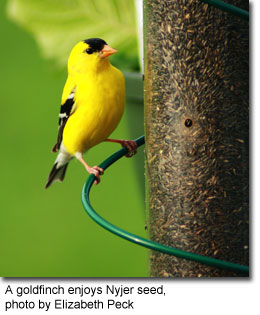
Suet
Commercial suet cakes or fresh suet mixed with sunflower and other seed will make a favored treat for cardinals, woodpeckers, nuthatches and chickadees. Most commercially available varieties don't melt in the sun, and the best times to feed suet are in the fall and winter months. Suet is the fat that surrounds the kidneys of beef cattle. Many food stores will carry it, if requested. One word of caution concerning raw suet: it can go rancid in the sun, so only offer it on cold winter days. If you live in an area with black bears, then it is best to only offer suet when the black bears are hibernating.
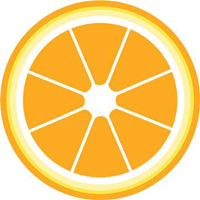
Fruit
Oranges, apples, grapes, and fruit cocktails can attract a variety of bird species to your backyard, including seed eating birds like tanagers. Only fresh fruit should be offered to birds as many dried fruits have added sugars that are harmful to birds. Fresh fruit can be placed on railings, nailed to trees or hung from branches. Be sure to clean fruit feeders every few days and remove any moldy fruit that may be left. Orange slices are an excellent attractant for Baltimore Orioles in the spring, but be careful of ants and wasps which might also enjoy fruit offerings.
Mealworms
Mealworms might not be so appetizing to us, but to many species of birds, mealworms are a very tasty meal. Mealworms provide an excellent source of protein, calcium and vitamins. Bluebirds, in particular, can really benefit from mealworm supplements in the winter and during early spring. Mealworms can be offered in special feeders or on platforms.
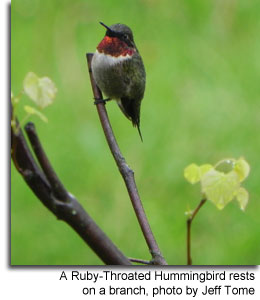
Nectar
Nectar, a sugar solution, is a favorite food of hummingbirds. Attracting these tiny, colorful birds is a highlight in any bird lover's experience. Nectar can be bought in packages, or it can be made at home. To make hummingbird nectar, take one part sugar and add it to four parts water. Bring the solution to a boil to kill any potential fungi or bacteria. Be sure to change your nectar solution and thoroughly clean your nectar feeders every two to three days. The fungus and bacteria that accumulate in nectar feeders can kill hummingbirds.
In Maryland, the most common hummingbird is the Ruby-Throated Hummingbird which often spends the spring and summer here. Occasionally, juvenile ruby-throated hummingbirds and other species will overwinter in Maryland. If you have a hummingbird feeder, then don’t take it down until two weeks after the last hummingbird is seen in late fall.
Types of Feeders
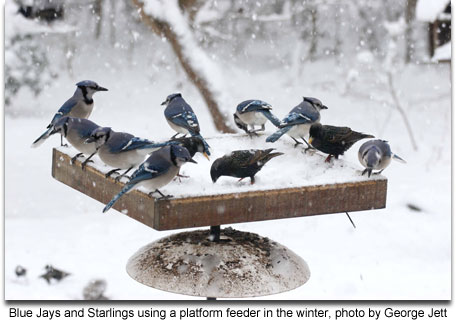
Bird feeders come in lots of shapes and sizes and are fashioned to supply foods that attract particular groups of birds. If you are a home carpenter or craftsperson, then you can make bird feeders out of a variety of materials from wood to old plastic soda bottles.
Hopper Feeders
Hopper feeders are designed to look like houses. They typically have 4 walls and a roof to keep seeds clean and dry. Hopper feeders can come in elaborate designs and can have squirrel-proofing features. Hopper feeders are generally designed to hold larger seeds and feed larger birds.
Platform Feeders
Platform feeders can be easily made from treated plywood with raised edges and will draw in those birds that feed on the ground some or all of the time. Cardinals, blue jays, juncos, sparrows and mourning doves will flock to a mixture of millet, sunflower, cracked corn, and peanut kernels in this type of feeder.
Platform feeders can also be used to offer mealworms and fruit to birds. Platform feeders are best used when mounted on poles that have predator baffles on them.
Tube Feeders
Tube feeders are especially attractive to smaller birds and are comprised of a plastic or glass tube filled with seeds. Tube bird feeders are designed to keep seed clean and dry. Tube feeders with metal feeding ports are better for areas with more squirrel traffic. Some types of tube feeders are specially designed to hold small seeds like Nyjer seeds.
Bird Feeding Tips
To attract a variety of birds, use a variety of foods throughout your yard
Plant native trees, shrubs and flowers for additional food and cover
Be sure to clean your feeders once every two weeks or more often if seeds get wet or if sick birds visit your feeder. Dirty feeders can spread disease, and spoiled seed can make birds sick.
To prevent raptors from eating your feeder birds, be sure to place feeders near shrubs or cover except if the feeders are on or near the ground
To prevent squirrels, put feeders on poles away from your house or from trees, with guards on the poles to prevent the squirrels from accessing the seed. If squirrels become a real problem for you, then stop feeding the birds for awhile.
To reduce fighting among birds at your feeders, add more feeders. Adding feeders can also help reduce the spread of disease by dispersing, instead of concentrating, the number of birds.
Avoid feeding bread or other table scraps to birds or other wildlife. These foods can spoil quickly and grow bacteria and mold which can harm or even kill songbirds. Bread is also similar to “junk food” for birds and does not provide the proper nutrition. Salted and/or sugared foods can be dangerous for small birds.
Ground hard-boiled egg shells can provide calcium and grit essential for birds. Make sure eggs are cooked before providing shells or bake shells for 20 minutes at 250 degrees to sterilize them.
Rake up and remove old seed hulls and spilled seed at least once a week. Select high quality seeds or no waste blends to reduce the amount of discarded seed. If rodents become a problem, then it may be best to remove bird feeders.
- If you live in an area that has black bears, then only place feeders out during late fall and winter when bears are hibernating. Remove bird feeders in the spring. If you continue to feed birds during summer, remove seed, suet, and hummingbird feeders at night. In the spring and summer, insects are the best food for birds, however.
Invite Wildlife to Your Backyard!
For more information, please contact:
Maryland Department of Natural Resources
Wildlife and Heritage Service
Tawes State Office Building, E-1
Annapolis MD 21401
410-260-8540
Toll-free in Maryland: 1-877-620-8DNR
[email protected]
Acknowledgements:
- Blue Jay, photo by David Kazyak
- A goldfinch enjoys Nyjer seed, photo by Elizabeth Peck
- A Ruby-Throated Hummingbird rests on a branch , photo by Jeff Tome
- Blue Jays and Starlings using a platform feeder in the winter, photo by George Jett